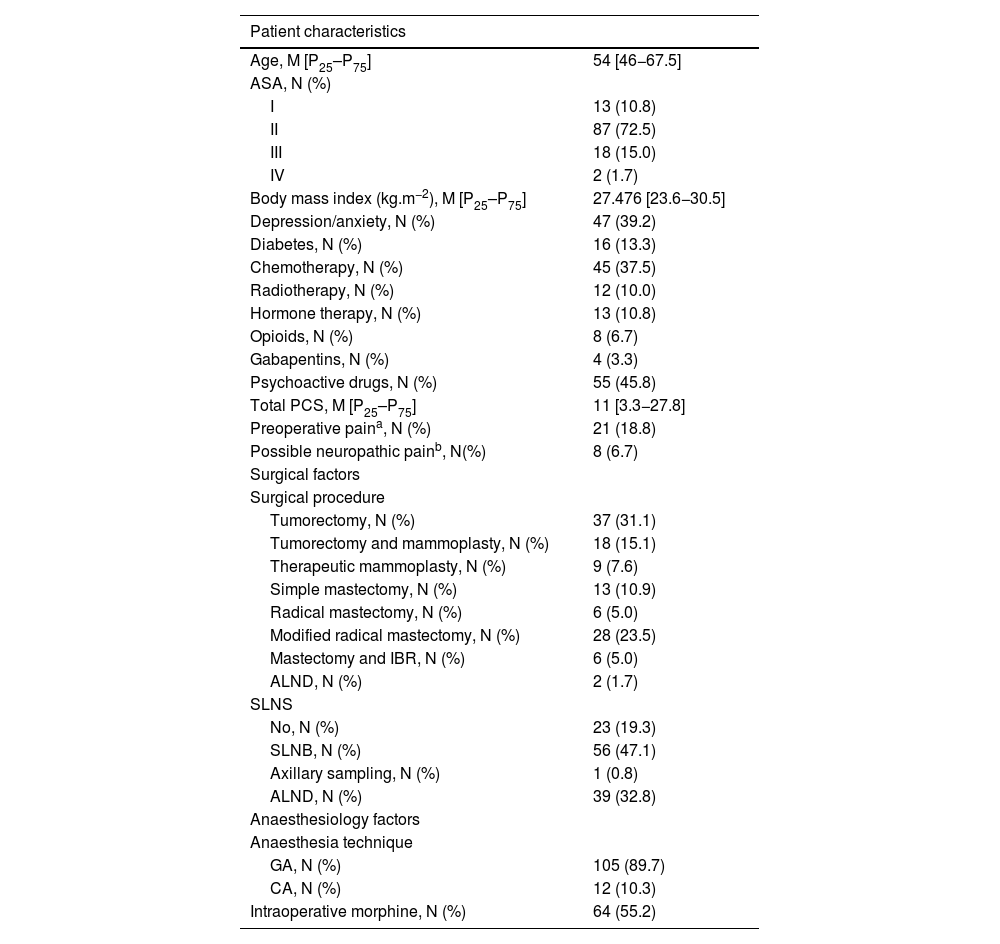Breast cancer is the most frequently diagnosed malignancy, and chronic pain after breast surgery (CPBS) is an increasingly recognized therapy-related problem. We evaluated CPBS incidence, characteristics, associated factors, and impact on patient quality of life (QoL).
Materials and MethodsSix-month observational prospective study conducted in patients undergoing breast surgery in a tertiary university hospital. Data were collected using several questionnaires: Pain Catastrophizing Scale, Brief Pain Inventory-Short Form, Douleur Neuropathique 4 Questionnaire, and European Organization for Research and Treatment of Cancer Quality of Life Questionnaire and its Breast Cancer Module.
ResultsA total of 112 patients completed the study. Approximately, one third (34.8%) developed CPBS, and almost all with potentially neuropathic pain. CPBS interfered with patients’ daily life and reduced their QoL. Diabetes (p = 0.028), catastrophizing (p = 0.042), and acute postoperative pain severity (p < 0.001) were associated with CPBS.
ConclusionsThis study broadens our understanding of CPBS and shows the impact of this syndrome. Healthcare workers need to be aware of CPBS and take steps to prevent and treat it, and provide patients with adequate information.
El cáncer de mama es la neoplasia más frecuentemente diagnosticada, y el dolor crónico postoperatorio (DCPO) es un problema relacionado con la terapia crecientemente reconocido. Evaluamos la incidencia del DCPO, sus características, factores asociados e impacto en la calidad de vida (CdV) del paciente.
Materiales y MétodosSe realizó un estudio prospectivo observacional de seis meses en pacientes sometidos a cirugía de mama en un hospital universitario terciario. Los datos se recopilaron utilizando diversos cuestionarios: Pain Catastrophizing Scale, Brief Pain Inventory-Short Form, Douleur Neuropathique 4, European Organization for Research and Treatment of Cancer Quality of Life Questionnaire y Breast Cancer Module.
ResultadosUn total de 112 pacientes completaron el estudio, de los cuales aproximadamente un tercio (34,8%) desarrollaron DCPO, y casi todos ellos dolor neuropático potencial. El DCPO interfirió con la vida diaria de los pacientes y redujo su CdV. La diabetes (p = 0,028), la catastrofización (p = 0,042) y la gravedad del dolor posoperatorio agudo (p < 0,001) se asociaron a DCPO.
ConclusionesEste estudio amplía nuestra comprensión sobre el DCPO y muestra el impacto de este síndrome. Los profesionales sanitarios deben ser conscientes del DCPO, y tomar medidas para prevenirlo y tratarlo, proporcionando a los pacientes la información suficiente.
Artículo
Comprando el artículo el PDF del mismo podrá ser descargado
Precio 19,34 €
Comprar ahora










